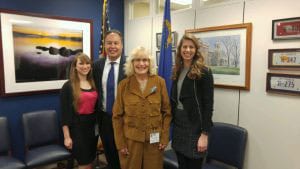Wednesday of Rare Disease Week was Lobby Day!
Patients, parents and advocates “stormed Capitol Hill” after a Lobby Day breakfast with speakers that included the newly confirmed FDA Commissioner, Robert M. Califf, MD, MACC, the House Energy and Commerce Committee Chairman Fred Upton, and Representative Gus Bilirakis.
All of us had been briefed on specific pieces of legislation to help us with our “asks” as we met with members of Congress and their aides.
These topics of discussion were: the OPEN Act (encourages the repurposing of existing drugs for rare disease indication), the Rare Disease Fund Act (would help close the funding gap between basic research and clinical research by establishing a private investment fund at NIH), The Patient Focused Impact Assessment Act (would encourage more patient engagement in the medical product review process) and asking for membership of the Rare Disease Congressional Caucus.
I had the privilege of lobbying with Paula Halicki from The International Pemphigus & Pemphigoid Foundation (IPPF) and Robert Ostrea from the Little Miss Hannah Foundation. Here is a picture of us with Senator Dean Heller’s Legislative Assistant, Rachel Green.
Paula and I then visited the office of Senator Harry Reid and even got to meet Congressman Cresent Hardy himself in the House of Representatives office building.
I advocated for the various pieces of legislation, quoted some statistics like: 95% of known rare disease have no approved treatment, and 30 million Americans are currently living with a rare disease. Paula shared her story: She was working as a parole officer when one day she noticed her duty belt was starting to hurt her. Soon even the light touch of her clothes on her body became excruciating. It took several doctors and several months, but she was finally diagnosed with pemphigus vulgaris.
Pemphigus is a genetically-based, auto-immune disease that can be fatal. The skin layers fail to adhere, causing blistering and painful open sores. After a lot of individual research she came across anecdotal evidence of a treatment that might help – a chemotherapy that was not approved for the treatment of her disease…but that was her only real hope. In order to obtain this treatment she had to sell her home and move to California where she could receive the treatment. While it’s not a cure it has helped her to resume working and to keep flares to a minimum. However, she is now back to governmental work in a state where she is having difficulty getting knowledgeable medical care, and most likely would have to leave her job and return to California if her disease worsens.

The meetings went well…we were listened to attentively and can hope that we made an impression that will make a difference. The next day I was pleased to note several of the Legislative Aides we spoke with in attendance at the Rare Disease Congressional Caucus briefing.
I know I, for one, went home hopeful that these acts that have potential to facilitate the creation of countless more treatments for patients with rare disease will pass. I also went home happy that I had the opportunity to meet so many wonderful people!







